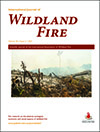International Journal of Wildland Fire
Volume 30
Number 2 2021
We developed an agent-based model simulating the interactions between human-induced ignitions, fire and peat characteristics that are assumed to be key for tropical peatland burning events. Our results emphasise the risk of a sudden shift of the system from moderate fire occurrence to complete burning. They highlight the importance of peat moisture regulation for peatland fire management.
Using case studies from the south-east Queensland bioregion, this study demonstrates the relevance of diverse spatial databases for prescribed burn planning, implementation and adaptive monitoring of operational targets. Comparison between available resources and actual burn practices has identified the potential for improved use of spatial databases for holistic fire management.
We used complementary approaches to map wildfires and estimate their recurrence in a tropical Andean region, the Iguaque mountains, Colombia. Wildfires represent a significant disturbance in these forests and have contributed to the severe decrease in extent of Quercus humboldtii forests and their fragmentation.
A processing routine to extract burned polygons from yearly satellite images is presented. These methods are specifically designed for regions where prior information on fire locations is missing and automatic change detection operations are limited by technical difficulties. Error margins are smaller than 20% for both over- and underestimations.
Wildfire models provide valuable information on potential wildfire activity, given different vegetation, population and climate scenarios. Analysing predicted wildfire events through a space–time approach and identifying hot spot areas enhances our ability to visualise and understand patterns of wildfire activity, mitigate risk and make informed decisions.
The generation of ‘hot’ firebrands is key in the propagation of wildfires. A methodology to enumerate these firebrands using a fire-resistant fabric is demonstrated in this paper. Further, this methodology is deployed to study hot firebrand production rates for trees treated with and without a fire retardant.
 , Subyantoro Tri Pradopo, Hatma Suryatmojo, Bertha Maya Sopha, Allan Spessa and Uta Berger
, Subyantoro Tri Pradopo, Hatma Suryatmojo, Bertha Maya Sopha, Allan Spessa and Uta Berger




